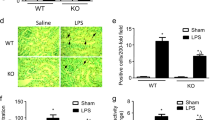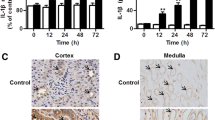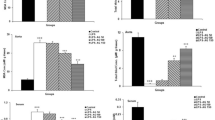Abstract
In the present study, we hypothesized that endotoxemia produces metalloendopeptidase (MEPD)-dependent generation of endothelin-1 (ET-1) and alters NOS expression correlating with p38-mitogen-activated protein kinase (MAPK) phosphorylation in thoracic aorta. Male Sprague-Dawley rats (350–400 g) were subjected to two groups randomly; sham-treated (N= 10) and lipopolysaccharide (LPS)-treated (N= 10) (E. coli LPS 2 mg/kg bolus + 2 mg/kg infusion for 30 min). The animals in each group were further subdivided into vehicle and MEPD inhibitor phosphoramidon (1 mg/kg bolus, PHOS)-treated groups. LPS produces a significant decrease in mean arterial pressure (MAP) at 2 h post endotoxemia that was blocked by PHOS. PHOS attenuated LPS-induced increase in tumor necrosis factor-alpha (TNF-α) concentration at 2- and 24 h post-LPS administration. LPS significantly elevated plasma concentrations of ET-1 at 2- and 24 h post endotoxemia. An upregulated preproET-1 expression following both LPS and MEPD inhibition was observed in thoracic aorta at 2 h post treatment. PHOS effectively blocked conversion of preproET-1 to ET-1 in thoracic aorta locally at 24 h post treatment in endotoxic rats. PHOS inhibited LPS-induced upregulation of inducible NOS (iNOS), downregulation of endothelial NOS (eNOS) and elevation of NO byproducts (NO x ) in thoracic aorta. PHOS also blocked LPS-induced upregulated p38-MAPK phosphorylation in thoracic aorta at 24 h post endotoxemia. The data revealed that LPS induces MEPD-sensitive inflammatory response syndrome (SIRS) at 2- and 24 h post endotoxemia. We concluded that inhibition of MEPD not only decreases the levels of ET-1 but also simultaneously downregulates protein expression of iNOS and phosphorylated p38-MAPK while increasing eNOS in thoracic aorta during SIRS in endotoxemia. We suggest that MEPD-dependent ET-1 and NO mechanisms may be involved in endotoxemia-induced altered p38-MAPK phosphorylation. (Mol Cell Biochem 265: 47–56, 2004)
Similar content being viewed by others
References
Glauser MP, Zannetti G, Baumgartner J-D, Cohen J: Septic shock: patho-genesis. Lancet 338:732–736, 1991
Suffredini AF, Fromm RE, Parker MM, Brenner M, Kovacs JA, Wesley RA, Parillo JE: The cardiovascular response of normal humans to the administration of endotoxin. New Engl J Med 321: 280–287, 1989
Nakaki T, Otsuka Y, Nakayama M, Kato R: Endothelium-accelerated hyporesponsiveness of norepinephrine-elicited contraction of rat aorta in the presence of bacterial lipopolysaccharide. Eur J Pharmacol 219: 311–318, 1992
Sharma AC, Sam II AD, Alden KJ, Moore S, Law WR, Ferguson JL: Central versus peripheral mediation of naloxone's perfusion effects in endotoxic rats. Shock 14: 441–446, 2000
Olsson LE, Wheeler MA, Secca WC, Weiss RM: Bladder instillation and intraperitoneal injection of Escherichia coli lipopolysaccharide up-regulate cytokines and iNOS in rat urinary bladder. J Pharmacol Exp Ther 284: 1203–1208, 1998
Salter M, Knowles RG, Moncada S: Widespread tissue distribution, species distribution and changes in activity of Ca 2 +-dependent and Ca 2 +-independent nitric oxide synthesis. FEBS Lett 291: 145–149, 1991.
Stein B, Frank P, Schmitz W, Scholz H, Thoenes M: Endotoxin and cy-tokines induce direct cardiodepressive effects in mammalian cardiomy-ocytes via induction of nitric oxide synthase. J Mol Cell Cardiol 28: 1631–1639, 1996
Yanagisawa M, Kurihara H, Kimura S, Tomobe Y, Kobayishi Y, Mitsui Y, Yazaki Y, Goto K, Masaki T: A novel potent, vasoconstrictor peptide produced by vascular endothelial cells. Nature 332: 411–415, 1988
Guha M and Mackman N: LPS induction of gene expression in human monocytes. Cell Signal 13: 85–94, 2001
Sharma AC, Motew SJ, Farias S, Alden KJ, Bosmann HB, Law WR, Ferguson JL: Sepsis alters myocardial and plasma concentrations of endothelin and nitric oxide in rats. J Mol Cell Cardiol 29: 1469–1477, 1997
Gupta A, Sharma AC: Metalloendopeptidase inhibition regulates phos-phorylation of p38-mitogen activated protein kinase and nitric oxide synthase in heart following endotoxemia. Shock 20: 375–381, 2003
Bogoyevitch MA, Ketterman AJ, Sugden PH: Cellular stresses differentially activate c-Jun N-terminal protein kinases and extracellular signal-regulated protein kinases in cultured ventricular myocytes. J Biol Chem 270: 29710–29717, 1995
Clerk A, Bogoyevitch MA, Anderson MB, Sugden PH: Differential ac-tivation of protein kinase C isoforms by endothelin-1 and phenylephrine and subsequent stimulation of p42 and p44 mitogen-activated protein kinases in ventricular myocytes cultured from neonatal rat hearts. J Biol Chem 269: 32848–32857, 1994
Liu W, Kato M, Itoigawa M, Murakami H, Yajima M, Wu J, Ishikawa N, Nakashima I: Distinct involvement of NF-ê Band p38 mitogen-activated protein kinase pathways in serum deprivation-mediated stimulation of inducible nitric oxide synthase and its inhibition by 4-hydroxynonenal. J Cell Biochem 83: 271–280, 2001
Tracey, WR, Tse J, Carter G: Lipopolysaccharide-induced changes in plasma nitrite and nitrate concentrations in rats and mice: Pharmaco-logical evaluation of nitric oxide synthase inhibitors. J Pharmacol Exp Therapeut 272: 1011–1015, 1995
Pollack JS, Nakane M, Buttery LDK, Martinez A, Springdall JM, Polak JM, Forstermann U, Murad F: Characterization and localization of en-dothelial nitric oxide synthase using specific monoclonal antibodies. Am J Physiol 265: C1379–C1387, 1993
Mazzocchi G, Albertin G, Nussdorfer GG: Adrenomedullin (ADM), acting through ADM (22-52)-sensitive receptors, is involved in the endotoxin-induced hypotension in rats. Life Sci 66(15): 1445–1450, 2000
Bone RC: Toward a theory regarding the pathogenesis of the systemic inflammatory response syndrome: What we do and what we do not know about cytokine regulation. Crit Care Med 24: 163–172, 1996
Cadenas S, Cadenas AM: Fighting the stranger-antioxidant protection against endotoxin activity. Toxicology 180: 45–63, 2002
Suda H, Aoyagi T, Takeuchi T, Umezawa H: A thermolysin inhibitor produced by actinomycetes: Phosphoramidon. J Antibiotics 26: 621–623, 1973
Ohnaka K, Takayanagi R, Nishikawa M, Haji M, Nawata H: Purifi-cation and characterization of a phosphoramidon-sensitive endothelin-converting enzyme in porcine aortic endothelium. J Biol Chem 268: 26759–26766, 1993
Turner AJ, Murphy LJ: Molecular pharmacology of endothelin convert-ing enzymes. Biochem Pharmacol 51: 91–102, 1996
Arriero MM, de la Pinta JC, Escribano M, Celdran A, Munuoz-Alameda L, Garcia-Canete J, Jimenez MA, Casado S, Farre J, Lopez-Farre A: Aspirin prevents Escherichia coli lipopolysaccharide-and Staphylo-coccus aureus-induced downregulation of endothelial nitric oxide syn-thase expression in guinea pig pericardial tissue. Circ Res 90, 719–727, 2002
Chauhan SD, Seggara G, Vo PA, Macallister RJ, Hobbs AJ, Ahluwalia A: Protection against lipopolysaccharide-induced endothelial dysfunction in resistance and conduit vasculature of iNOS knockout mice. FASEB J 17: 773–775, 2003
Loke KE, McConnell PI, Tuzman JM, Shensely EG, Smith CJ, Stackpole CJ, Thompson CI, Kaley G, Wolin MS, Hintze TH: Endogenous endothelial nitric oxide synthase-derived nitric oxide is a physiological regulator of myocardial oxygen consumption. Circ Res 84: 840–845, 1999
DePlaen IG, Qu XW, Wang H, Tan XD, Wang L, Han XB, Rozenfeld RA, Hsueh W: Endotoxin, but not platelet-activating factor, activates nuclear factor-kappaB and increases IkappaBalpha and IkappaBbeta turnover in enterocytes. Immunology 106: 577–583, 2002
LaPointe MC, Isenovic E: Interleukin-1beta regulation of inducible ni-tric oxide synthase and cyclooxygenase-2 involves the p42/p44 and p38 MPAK signaling pathways in cardiac myocytes. Hypertension 33: 276–282, 1999
McKenna TM, Li S, Tao S: PKC mediates LPS-and phorbol-induced cardiac cell nitric oxide synthase activity and hypocontractility. Am J Physiol 269: H1891–H1898, 1995
Kubo T, Ibusuku T, Chiba S, Kambe T, Fukumori R: Mitogen-activated protein kinase activity regulation of angiotensin and endothelin systems in vascular smooth muscle cells. Eur J Pharmacol 411: 27–34, 2001
Author information
Authors and Affiliations
Rights and permissions
About this article
Cite this article
Gupta, A., Sharma, A.C. Despite minimal hemodynamic alterations endotoxemia modulates NOS and p38-MAPK phosphorylation via metalloendopeptidases. Mol Cell Biochem 265, 47–56 (2004). https://doi.org/10.1023/B:MCBI.0000044314.29395.fb
Issue Date:
DOI: https://doi.org/10.1023/B:MCBI.0000044314.29395.fb




